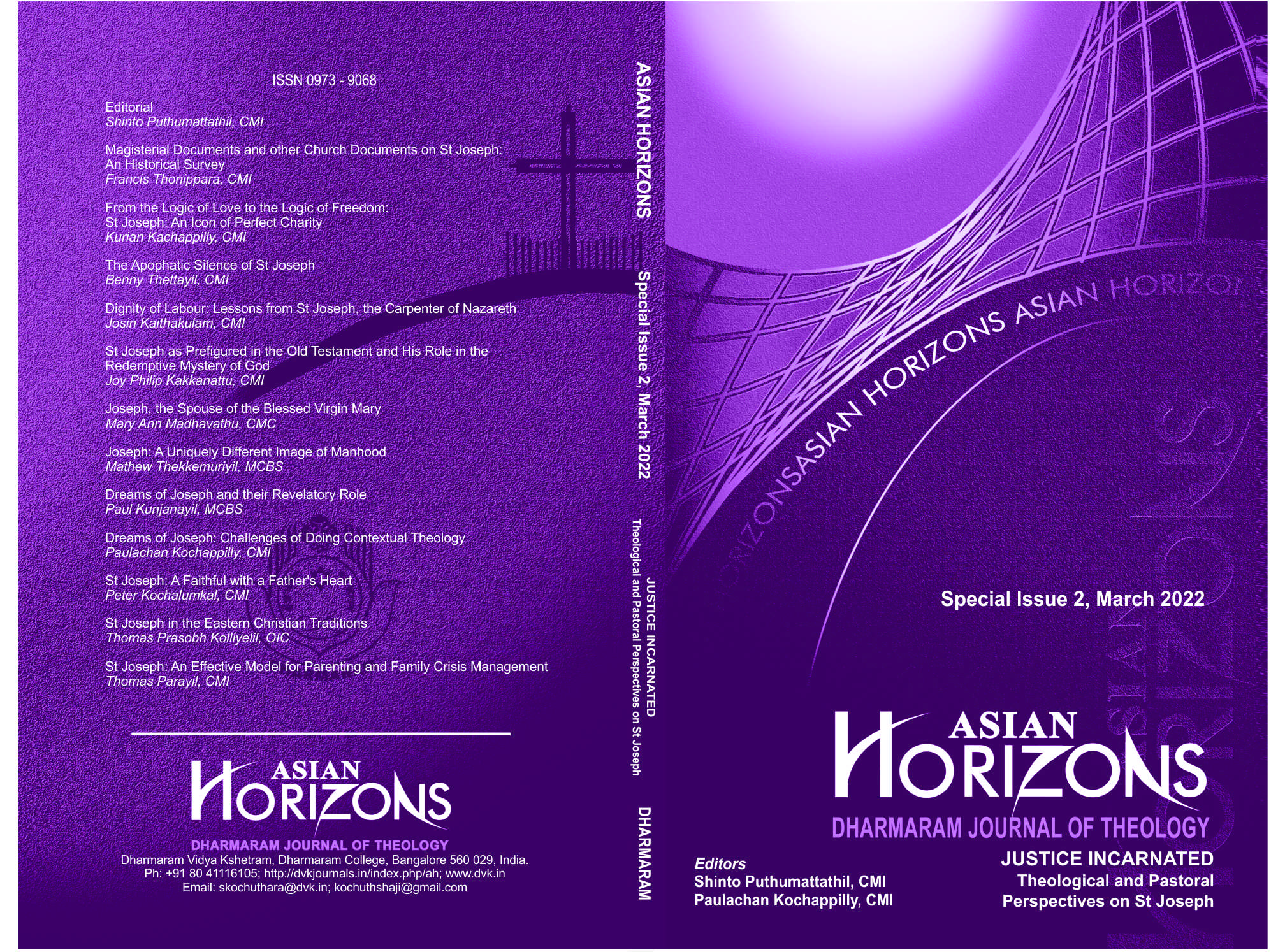THE APOPHATIC SILENCE OF ST JOSEPH
Keywords:
Apophatic Theology, John of the Cross, Mystic, Silence, Via NegativaAbstract
Focussing on the apophatic silence of St Joseph, reflections are made on the various challenging events in Joseph’s life to see how these perplexing and shocking events may have driven him into an equanimous silence that spoke eloquently about his experiences that may be termed as mystical. Challenging experiences are often powerful. When a mystery is experienced, the expression pertaining to is often incongruent and the language of the mystic is often silence. If at all, an expression of the experience is possible, the one who narrates the experience takes recourse to analogies. However, name, form and expression are so limited that they often lead to confusion. The mystical has often become “terrible” and the ineffability of mystical experience has the spirituals of various traditions have taken recourse to the wisdom of apophasis. As a mystic, Joseph welcomed the numinous as it came knocking at the first Christmas because this experience permeated his consciousness as it had the potential to be an inordinate blessing, even when the aftermath felt chaotic and hard to integrate. Though Joseph was delivered into the Dark Night, while the shock was like hell on earth, when it was resolved, it became a gift from God. It is this gift that turned Joseph into a silent monk of a father.
References
C.G. Jung, Collected Works 9i: Archetypes and the Collective Unconscious (Trans. R.F.C. Hull), Princeton, NJ: Princeton University Press, 1959.
C.M. Bache, Mysticism and Psychedelics: The Case of the Dark Night in Journal
Chandogya Upanishad with the Commentary of Sankaracarya, (trans. Swami Gambhirananda), Calcutta: Advaita Ashrama, 1983. p. xxxv. See also Kochumuttom, Comparative Theology, 37.
Diagnostic and Statistical Manual 5, APA 2013, 271-272.
J.G. Arapura, Hermeneutical Essays on Vedantic Topics, New Delhi: Motilal Banarsidas, 1986, 29, who holds that Brahman is throughout spoken as attributeless.
J.S. Croatto, Biblical Hermeneutics, Toward a Theory of Reading as the Production of Meaning, (trans. R.R. Barr, Spanish Original), Maryknoll: Orbis, 1987, 1.
John Welch, “Mystical Theology”, in Joseph A. Komonchak et al. (eds.). The New Dictionary of Theology, Bangalore: TPI, 2006, 692-694, 692-693.
K.A. MacLean, M.W. Johnson, R.R. Griffiths, “Mystical Experiences Occasioned by the Hallucinogen Psilocybin Lead to Increases in the Personality Domain of Openness,” Journal Psychopharmacol 25 (2011) 1453-1461.
Karl Rahner, Theological Investigations 4, Baltimore: Helicon Press, 1966, 225.
Kuncheria Pathil and Dominic Veliath, An Introduction to Theology, Bangalore: TPI, 2003, 6.
M. Eliade, Shamanism: Archaic Techniques of Ecstasy, Princeton, NJ: Princeton University Press, 1964.
New Dictionary of Theology, 48, 696.
Ninian Smart, The Phenomenon of Christianity, London: Collins, 1979, 157.
Otto, The Idea of the Holy.
Panikkar, Vedik Experience, 775.
Pathil, Introduction to Theology, 6, 158.
R. Otto, The Idea of the Holy, Trans. John W Harvey, London, UK: Oxford University Press, 1950.
Sankara comments that this negation is a device to teach the student about the student’s own status as Brahman. See Arapura, Hermeneutical Essays on Vedantic Topics, 112.
St Kuriakose Elias Chavara, in his meditations muses on the scene and compares the birth of Jesus with the appearance of the bright moon from the clouds!
Thomas Kochumuttom, Comparative Theology: Christian Thinking Spirituality in Indian Perspective, Bangalore: Dharmaram Publications, 1985, 32.
W. James, The Varieties of Religious Experience, New York, NY: Longmans, Green and Co, 1917.
W. Stace, Mysticism and Philosophy. London: Macmillan & Co, 1961.

